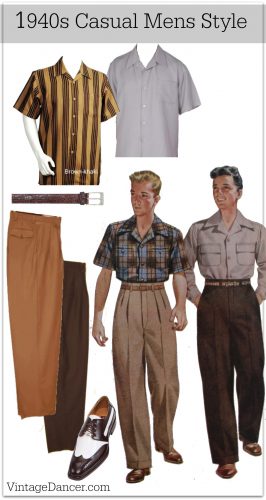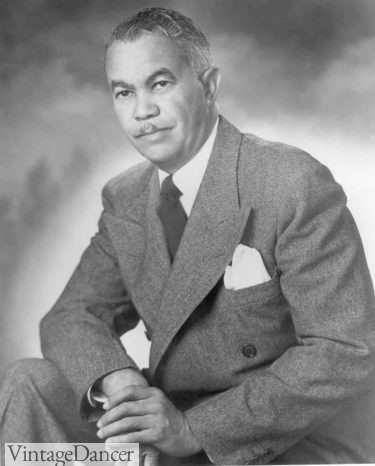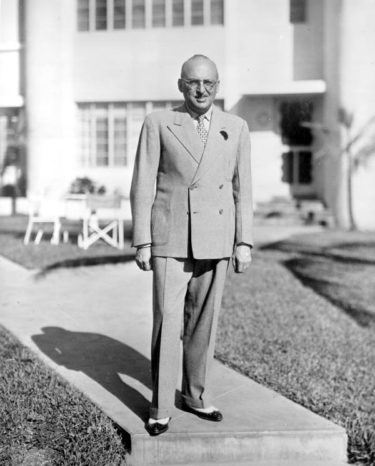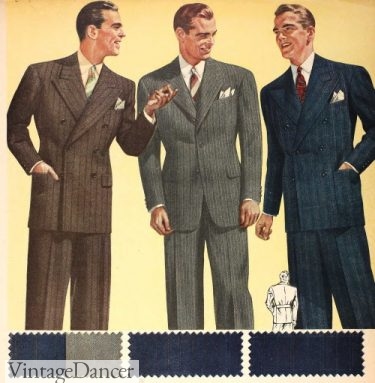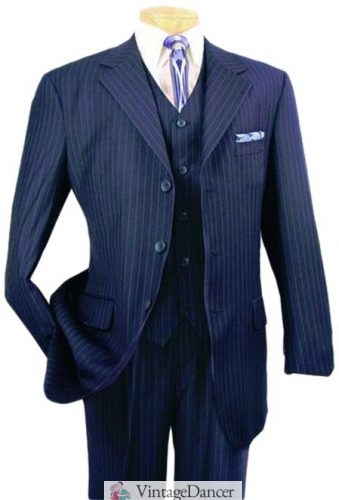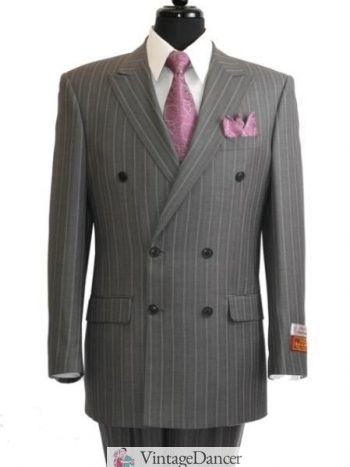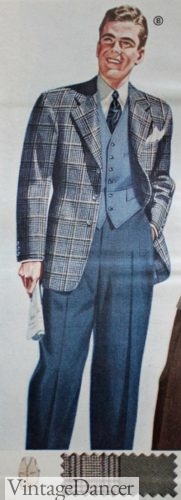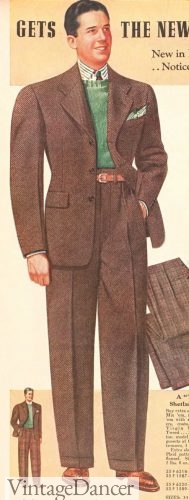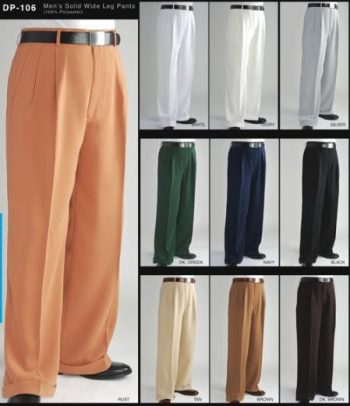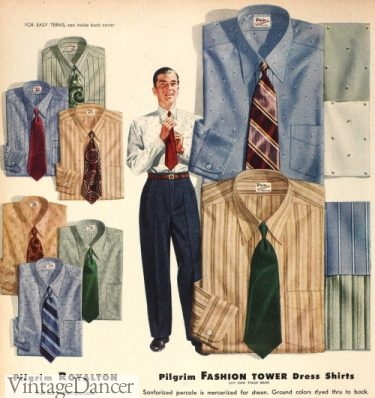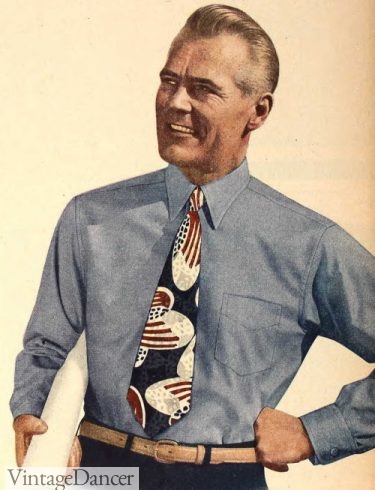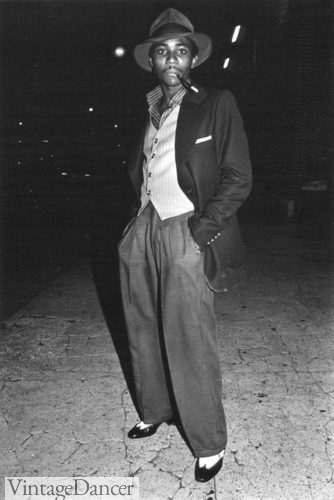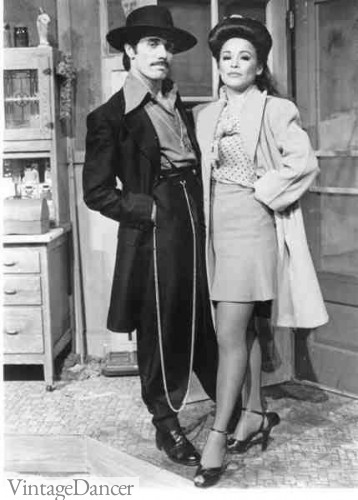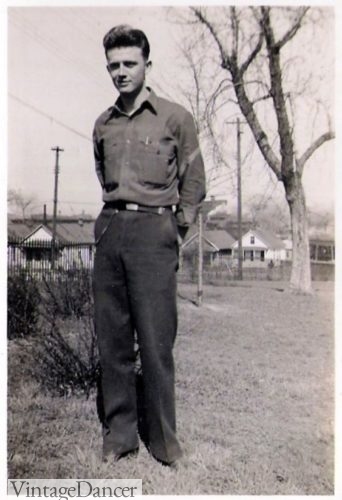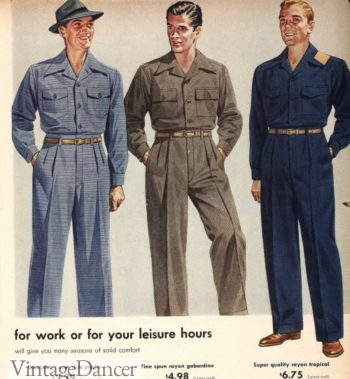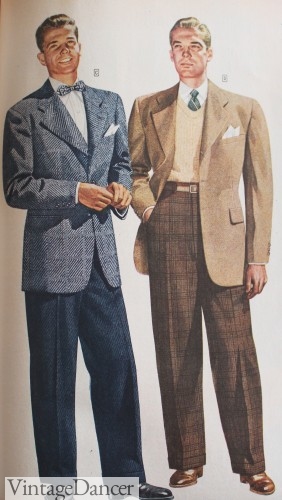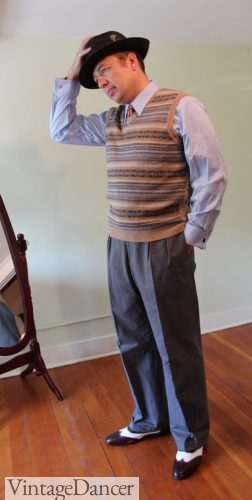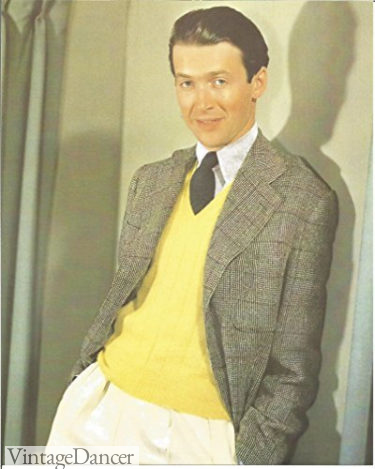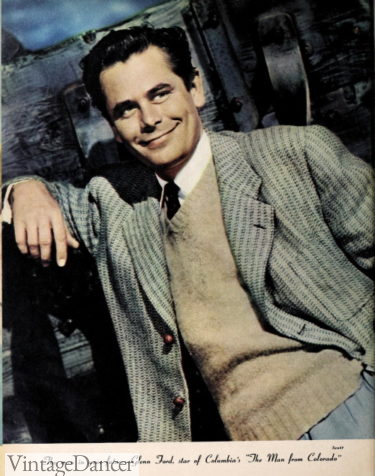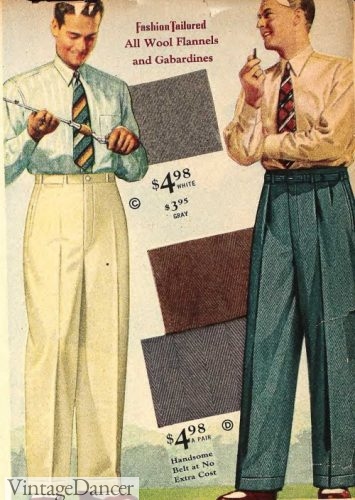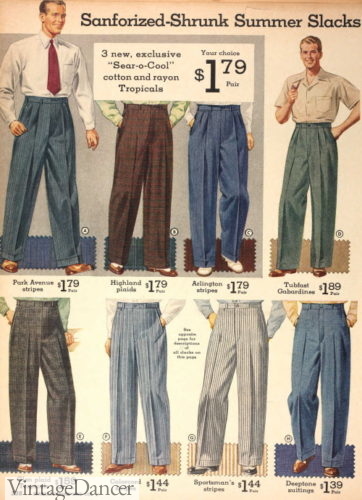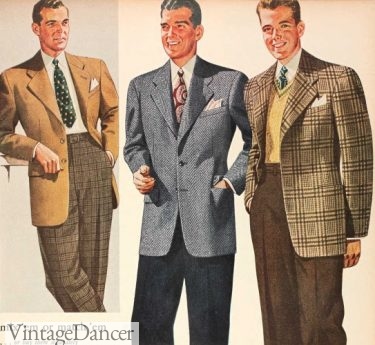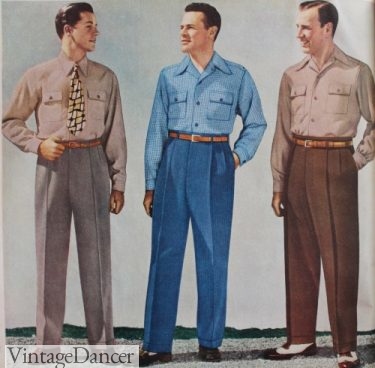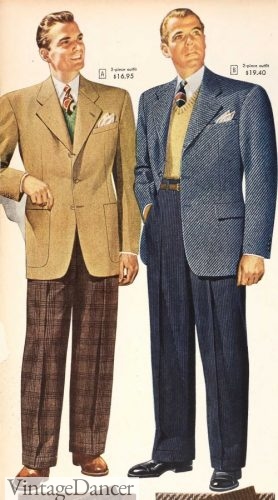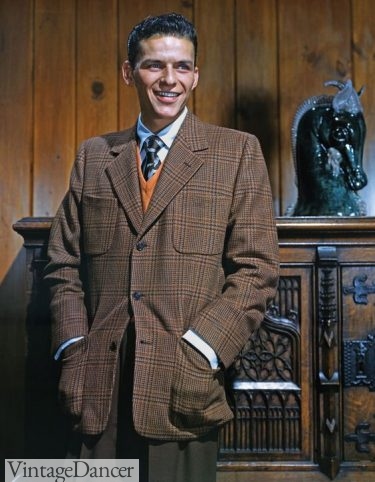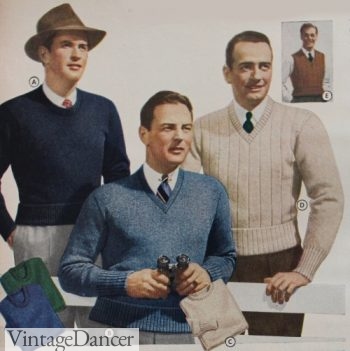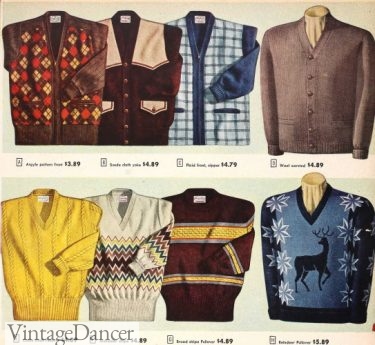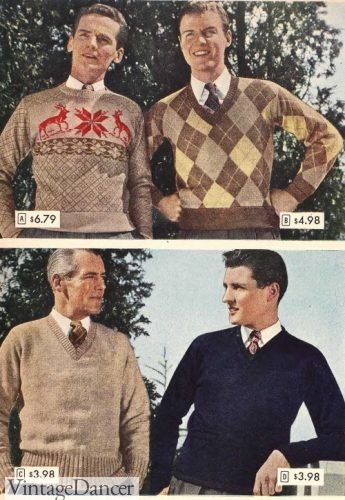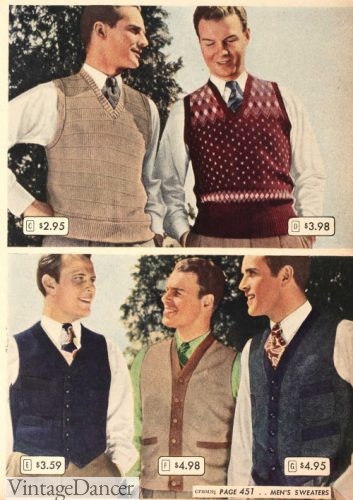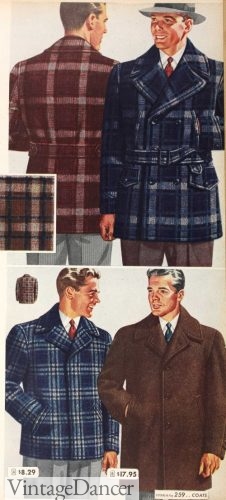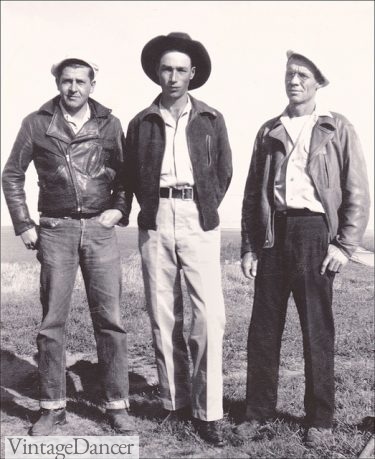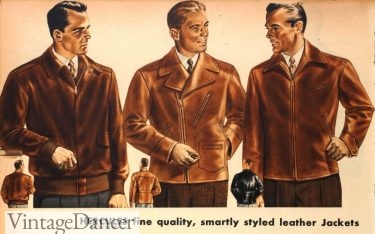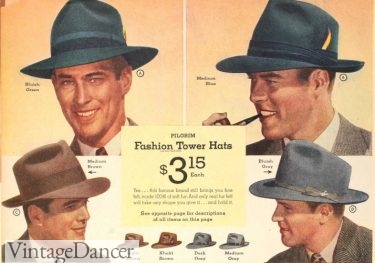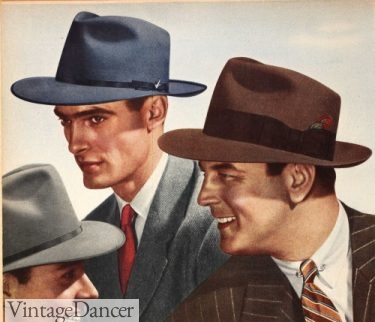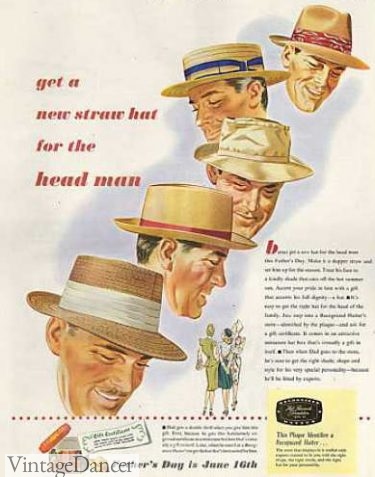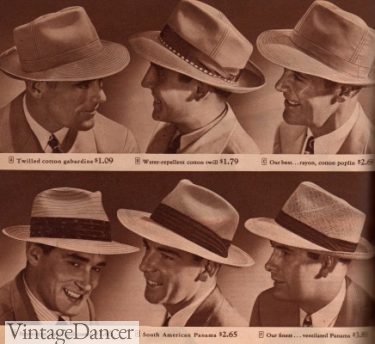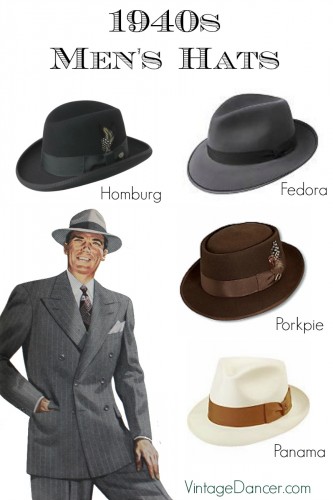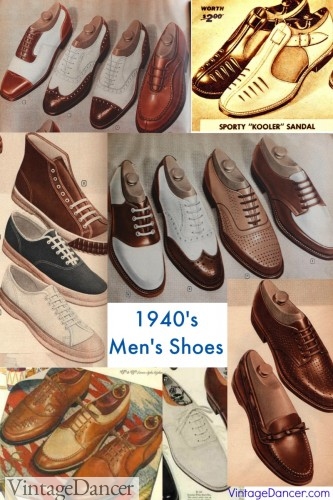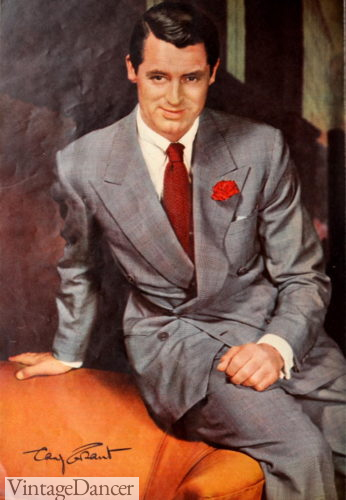
1941 Men’s fashion suit worn by Cary Grant
1940s men’s fashion for day, sport, or evening was styled to make a man feel “larger than life.” During 1941-1945, WWII fabric rations limited cloth to make suits but not style. Middle class men chose basic business suits that haven’t changed dramatically since the beginning of the century.
The notorious Zoot Suit with its bright colors, baggy legs, and long jackets was a complete deviation from the norm — an underground rebellion worn by inner city youth.
What makes 1940s men’s fashion unique to the decade is the cut of the clothes, the patterns, and the stylistic details that demonstrated one’s patriotic support of his country (or lack thereof).
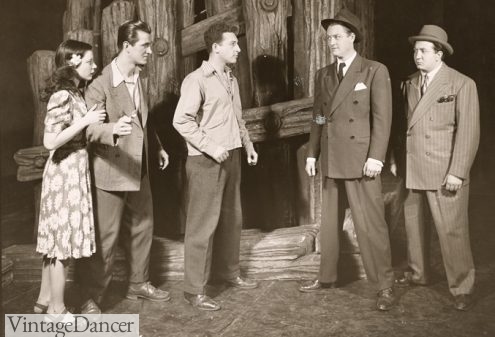
1941 actors rehearsing- both pre-war suits and casual clothing
Some of the key details of 1940s men’s fashion are high waisted and wide leg trousers, wide lapel suit coats and sport coats, wide collar shirts, colorful and wide neckties, two tone oxford shoes and wide brim fedora hats. Notice the trend was wide everything? Compared to today’s skinny fit, the 1940s were all about comfort through volume.
Walk through 1940s fashion history with me as we study what typical civilian men wore. Follow the links within for additional men’s 1940s fashion history and outfit ideas.
You can skip the history and begin shopping for men’s 1940s style clothing:
Suits | Shirts/knitwear | Trousers | Hats | Shoes | Reproduction Brands
1940s Men’s Fashion History
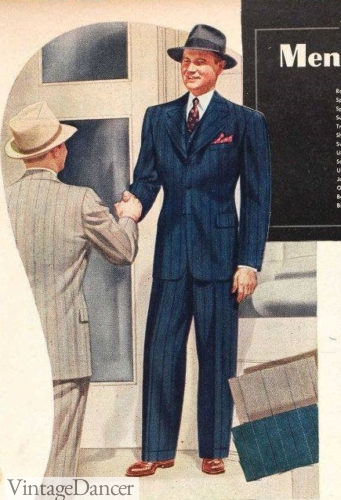
1941 blue or cream pinstripe suit
In the 1930s, men’s fashion was big. Big suits, big pants, big prints, big colors. The men’s 1940s clothes tamed the exaggerated and top heavy ’30s fit down to an even silhouette from shoulder to foot. Modifications were made to save on fabric during war time shortages.
During WWII, the USA war board placed restrictions on men’s clothing just as they did for women. Men’s 1940s suit pockets could not have flaps, trousers could not be more the 19 inches around or be cuffed, and suits were sold without vests (waistcoats). The cuffed look was so popular that men quickly figured out you could purchase longer length pants and cuff them at home.
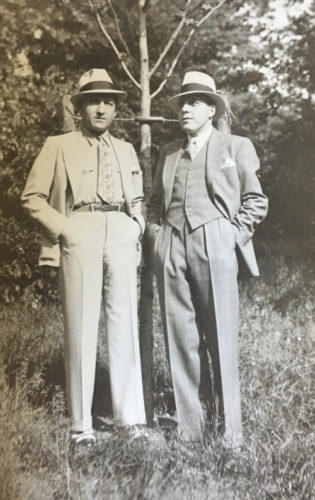
1940s men’s fashion suits and hats
In Britain, the men’s 1940s clothing restrictions were harsher. Jackets could not have pleated backs, metal zippers or buttons, feature raglan sleeves, or have half belts.
Most men kept their clothing from the 1930s and wore them through the early ’40s. It was a sign of support for the war to be seen in pre-war suits and overcoats. Shoes were re-soled and hats reshaped for as long as possible. Used clothes were handed down to family membership and remade into to looks.
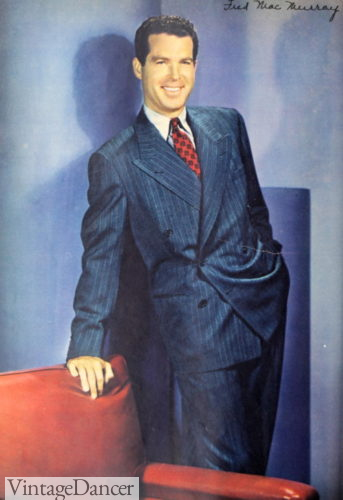
1941 Fred McMurry
War time clothing restrictions continued to influence men’s 1940s fashion design after the war by coping or modifying uniforms into civilian clothes. Trench coats, bomber jackets, knit undershirts, pea coats, chino pants, and aviator glasses all have roots in WWII military clothing.
With so much military surplus available after the war, civilians would buy and wear military clothing for several more years. The improvement in machinery, textiles, and manufacturing of military clothing made post-war ready-to-wear civilian clothing a booming industry with affordable new fabrics and faster production methods.
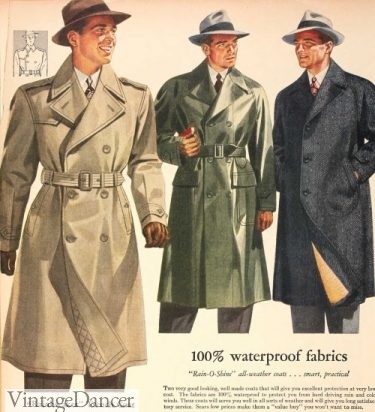
1943 trench coats, military inspired
The biggest influence WW2 restrictions had on men’s fashion was a further introduction of casualness. Men were tired of scratchy uniforms and confining suits. The freedom that casual 40s clothes brought to men was a big sigh of relief.
Hawaiian shirts, for example, were worn all day, and even during nights, in the summer. Strict codes of dress were impossible to enforce when the majority of people couldn’t afford a large wardrobe, even after the war ended.
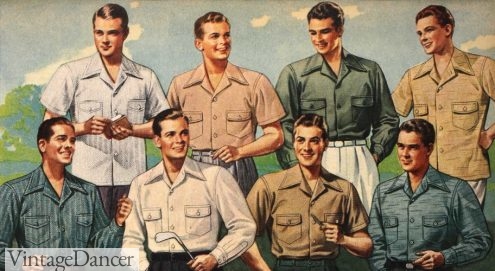
1941 men’s casual shirts
Ironically, the very clothing that caused such turmoil during the war years, the Zoot Suit, was the single piece of fashion that influenced men’s post-war clothing. Longer, looser jackets, double pleated pants, big hats, and even wider ties made their way into late ‘40s men’s fashions.
Men were eager to put the war behind them and embrace the clothing they were previously forbidden to wear.
1940s Men’s Fashion Suits
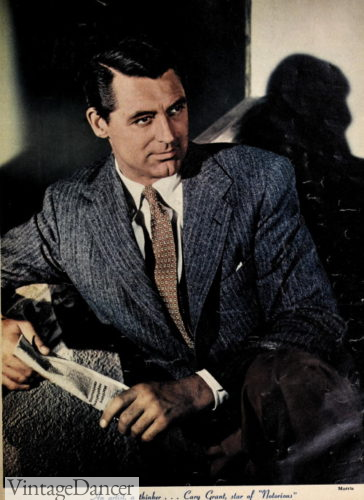
1948 Cary Grant
During the ‘40s, suits were still everyday wear for men, whether they were going to an office job, to a picnic or out to dinner. Even working classes and poor men tried to own at least one suit or sport coat to wear to Church on Sundays or for Holiday celebrations and special events.
Men’s 1940s suits were usually made from thick wool, worsted wool, or tweed, but during the war synthetic rayon fabrics blended with wool was usually used instead.
- Architect Paul Williams, late 1940s Double Breasted Wool Suit
- Mid 1940s double breasted suit with two tone shoes
Men’s 1940s suit colors were muted – black, navy, grey, dark brown, tan, and medium blue. During the summer, lighter fabric colors were medium grey, brown, medium blue, teal blue-green, and tan. White and ivory which had been incredible popular in the 1930s faded away slowly, only being worn in hot tropical climates.
Most men’s 40s suits were not solid colors. Tweed, herringbone, check, pinstripes and overplaids were very popular suiting patterns. Wide chalk stripes were also a classic ‘40s suit pattern.
- 1942 mens summer suits
- 1942 mens winter suits
The single-breasted jacket had 2-3 buttons, wide padded shoulders, patch or slit pockets, and tapered into the waist slightly. The lapels were wide notch or peak with rounded edges. The wide width made a man look bigger even though the cut was narrower than in the ’30s.
The double-breasted jacket was even more popular in the 1940s for the extra width it caused, although sales were restricted during the war years.
Learn more about 1940s men’s suit history or buy 1940s style suits like these here:.
- 40s style pinstripe vested suit
- Grey double breasted pinstripe suit
Men’s 1940s suit vests (waistcoats) were considered a wasteful item both in war time and after, and most men preferred not wearing a vest with their suits at all. It was cooler and more comfortable without them.
Matching suit vests were V-neck cut with 7-6 buttons and pockets on either side.
Suit vest could be of a light shade of the same colors but the more popular option was to wear a knit sweater vest with suits or sport coats. More about these later on in the article.
Buy vintage style men’s vests here.
- 1942 men’s sports coat with blue vest
- 1940 men’s suit with green sweater vest
1940s Men’s Trousers
The 1940s suit trouser, slacks or pants were usually flat-fronted or with single pleats. They were worn at the high waist (above the belly button) with a 3 inch wide waist band. Trouser legs were wide around the thigh, knee and slightly tapered ankle which are the opposite of today’s “skinny” suits.
Usually, suit trousers were either straight hemmed at the bottom as required during the war or had 2 inch trouser cuff (turnups) which most American men preferred.
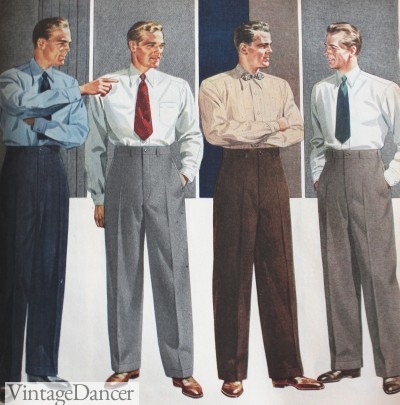
1944 Suit Pants, Dress Shirts and Ties
Wide leg and high waisted pants are difficult to find in stores today (although this is slowly changing. Here are some options to buy men’s wide leg pants online.
What did 1940s men wear to keep their pants up? Suspenders were still worn by men in the 1940s although belts were more popular.
Men’s 1940s suspenders came in thick elastic stripes with button loops. Buttons were sewn into the inside waistband to attach suspenders too. Clip on suspender came into fashion in the later years. Shop suspenders.
Suspenders were rarely visible. Men’s suspenders were worn under a suit vest or sweater vest or hidden behind the suit or sportscoat. Wearing exposed suspenders in public, especially around women was a kin to being in underwear.
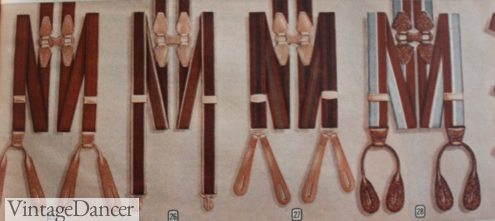
1940s button or clip suspenders
1940s men’s belts had largely replaced suspenders as pants became more fitted at the waist. They were about an inch or so wide with small metal buckles that were often covered in matching leather. The belt leather was tan, brown or black and could be plain or pebbled, braided or stamped with a Western motif.
History of 1940s suspenders and belts.
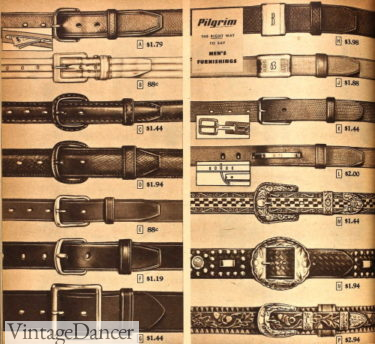
1947 men’s belts
1940s Men’s Dress Shirts and Ties
Men’s 1940s button down dress shirt was worn with suits or by itself with a pair of slacks. Men’s 1940s dress shirts were usually made from cotton with an attached, large pointed collar called a spearpoint collar in the early 1940s and a shorter, classic collar in the late 1940s. Today’s modern collars are much smaller.
Men’s 1940s shirts were very colorful. White was an option but men choose blue, tan, yellow, green, or grey shirts in solid, thin stripes, or pin dot patterns. Shirt were worn tucked in, with an optional single pocket on the chest.
Read more 1940s men’s shirts (dress and casual) or buy 1940s style men’s shirts.
- 1943 Men’s Striped Shirts
- 1946 single pocket dress shirts
No 1940s men’s suit would be complete without the perfect tie! 1940s neckties were made exclusively from silk, rayon and wool. They were panel ties (made from one piece of fabric) and fairly wide (3.5 to 4.5 inches). 1940s ties were also worn short, up to two inches above the pants’ waistband (which was already worn high on the waist.)
Large geometrics, curly lines, monograms, and Art Deco style were done in bright patriotic colors. Animals, plants, flowers, birds, Western, and tropical themes were everywhere.
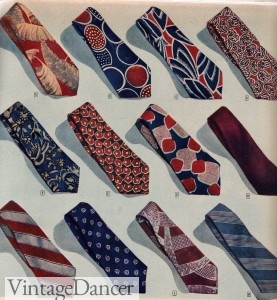
1940s Tie Patterns
Men’s 1940s ties were often themed around the wearer’s hobbies and interests like painting, fishing, or hunting. The crazier the tie, the better!
Bow ties were also still worn but less popular amoung young men.
Read more about men’s vintage ties here or buy 1940s vintage neckties.
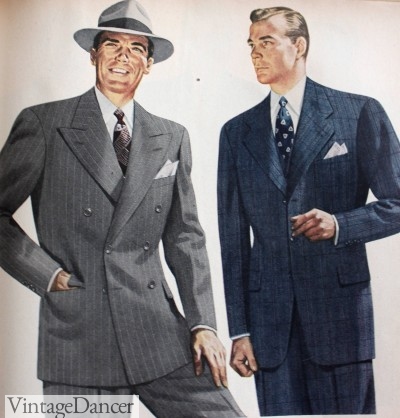
Folded Pocket Squares
No 1940s suit would be complete without a pocket square, also called a handkerchief. These were made from rayon or silk after the war and were often brightly colored, or they had paisley or other classic patterns.
Men’s 1940s pocket squares were folded into a triangle and placed open side up, exposing two or three tips.
Don’t use these for practical purposes – keep a plain white handkerchief in your pant pocket!
1940s Zoot Suits
Zoot suits had been popular at the start of the ‘30s. However, by the time the ‘40s rolled around, the suits were strongly associated with gangsters.
Most men were fighting overseas, and the over-sized suits – which went against fabric rations – were seen as unpatriotic.
Zoot suits were often pinstriped yellow, green, bright blue, and purple fabrics – the opposite of military drab.
- East Coast zoot suit outfit
- L.A. Zoot Suit
The 1940s zoot suit itself was an extremely loose, long, and wide two-button suit jacket with large notch lapels with huge shoulder pads worn over extremely baggy trousers that came about halfway up the ribs. The zoot suit pants tapered at the bottom to a very tight cuff at the ankle and were held up with suspenders.
A plain button-down shirt, wide tie, shiny leather shoes, and a wide-brimmed fedora hat completed the look on the east coast. In the west, the tie and hat were replaced by hair greased back into a ducktail. Read more about Zoot Suit fashion here.
It is interesting to note that despite the Zoot style being considered unpatriotic during the WW2, afterward the style became the new men’s look of the late ’40s and early ’50s.
Large double-breasted baggy suits with high waists, pleated trousers, and wide brim hats returned to fashion just as they were in the 1930s but now with a taste of the Zoot in them as well.
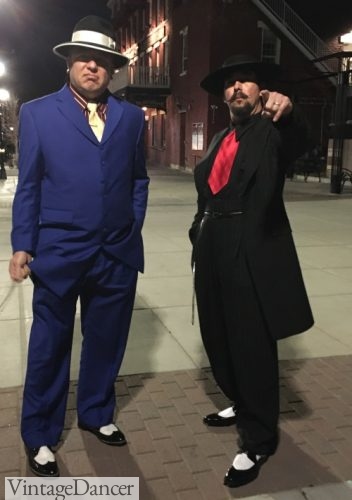
New Zoot suits. Shop here.
1940s Working Class Clothing
For men who didn’t wear suits to work, a collared shirt and work trousers in sturdy cotton twill or gabardine were the way to go. 1940s work trousers had flat fronts with a single leg crease. The leg widths were also generally narrower than men’s suit or casual pants.
1940s workwear trousers colors were fairly basic tan, brown, navy, and hunter green, although sometimes plaid was thrown into the mix.
A matching trouser and shirt set was common for most lines of blue collar work in the 1940s. Work shirts had open soft pointed collars, two patch pockets, pleating at the back, and large armholes for freedom in movement. A solid color tie worn with the work outfit kept men looking fine in public settings.
More about 1940s men’s work clothing.
- 1940s work pants, shirt and belt
- 1943 workwear sets
Sturdy cotton canvas coveralls were worn by men that had to get dirty on the job. In the 1940s, men’s coveralls were all one piece that buttoned down through the fly with a straight leg. They belted at the waist, had long sleeves for protection, and typically featured a pointed collar. They also had big patch pockets on the chest for keeping tools handy.
Denim overalls were another 1940s workwear clothing choice preferred by farmers.
Learn more about and buy men’s 1940s vintage workwear.
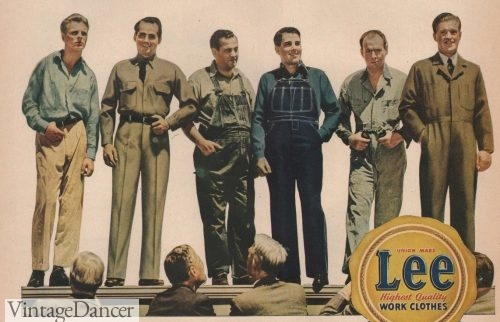
1945 Lee Workwear
1940s Men’s Casual and Sport Clothing
Postwar casualness opened the floodgates for 1940s men’s knit shirts, vests, and pullovers to dominate after-work casual hours. Solid colors and wide stripes were simple but it was the fun novelty prints and patterns that made them fun. Chain links, diamonds, fairisle, zig zags, plaid, and argyle patterns were trendy and colorful.
Men and boys also wore novelty designs of vacations sports, hobbies, sports, music and western themes.
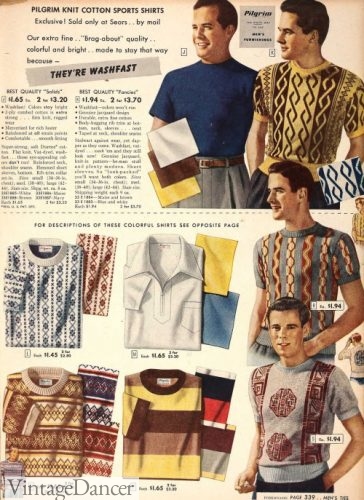
1949 knit shirts, novelty patterns
Men’s knitted shirts were made of textured ribbed knits that fit very snugly with a wide rib bottom and smaller ribbed sleeve and neck bands. Neckbands were almost always round and high on the neck with a small V-neck as an alternative style. The fit was snug to show off muscles.
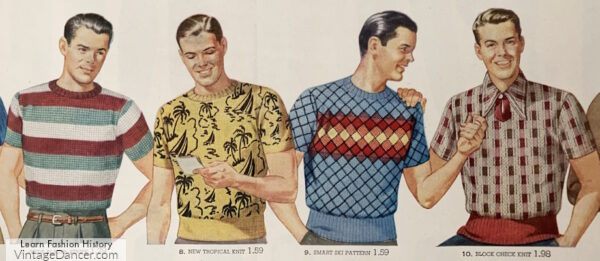
1948 men’s knit novelty shirts
Men’s 1940s knit sweater shirts could be worn tucked into pants or untucked.
The jersey knit T-shirt was a newer causal men’s clothing item in the 1940s. Initially men’s 1940s T-shirts were considered underwear but since most military men were issued undershirts men became accustomed to wearing them without an overshirt. They were cool and comfortable, perfect for a younger generation.
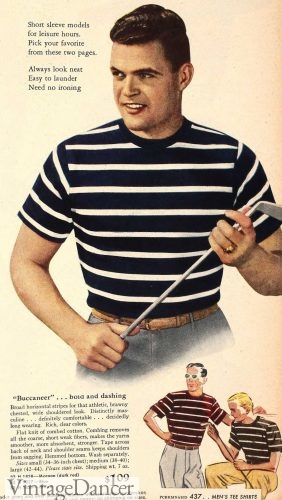
1947 Blue and White Stripe Shirt
Men’s 1940s T shirts were a flat soft jersey knit with a high crew collar, short cap sleeves and short waist. They came in basic colors: navy blue, powder blue, army green, maroon, mustard yellow and red in solid colors but more commonly thick and thin horizontal stipes. The striped T shirt differentiated men’s casual shirts from undershirts.
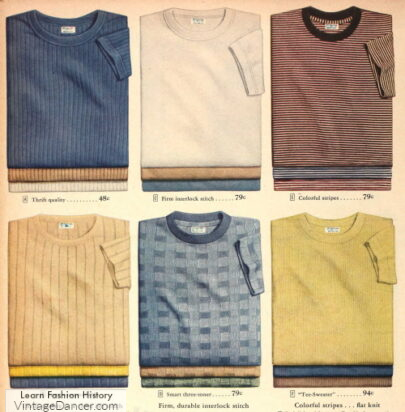
1946 Men’s T shirts and Knit Shirts
Shop men’s T shirts and knit shirts.
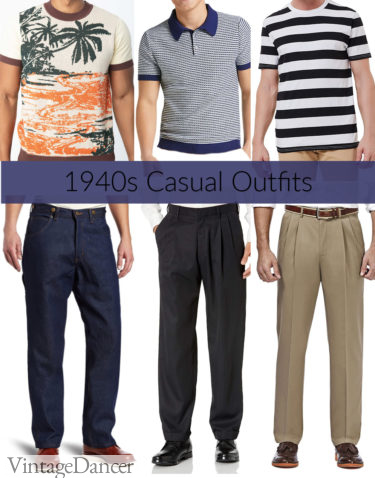
1940s casual shirts and pant outfits
Men’s 1940s pullover sweater vests could be worn tucked in or untucked, with the former being the most common style. Solid colors, wide horizontal stripes and “Norwegian” designs for winter were especially common. Sweater vests were worn over a dress shirt and necktie and topped with a sports coat.
- 1944 Casual Clothing with Sweater Vest
- A pullover vest creates an ideal 1940s casual style.
Men’s 1940s V-neck sweater vests (pullovers) were made in the same style and colors as shirts. In winter, they were knit of wool for extra warmth, and in summer with rayon/cotton blends. This three-piece look was especially popular with sport spectators.
Pullovers usually contrasted with the shirts underneath and the trousers, too, creating a very colorful outfit. For example, a tan shirt with green slacks and a blue pullover or a wine-colored shirt with navy pants and a grey pullover.
Learn more about men’s vintage sweaters and sweater vests history.
Buy men’s vintage style sweaters and sweater vests.
- Jimmy Stewart wearing a 1940s yellow knit vest, sportcoat and cream trousers
- 1947 Glen Ford’s tan sweater vest
1940s men’s casual collared shirts could have long or short boxy sleeves and were straight cut at the bottom. Large soft collars could also be worn closed just like dress shirts, but more often were worn open with the top button undone. Men’s 1940s casual shirts came with two chest pockets that had welt, button, or fold over flaps.
Men’s 1940s casual shirt colors could be plain tan, brown, blue, green or maroon, and plaids, checks, windowpane, and stripes were also very popular.
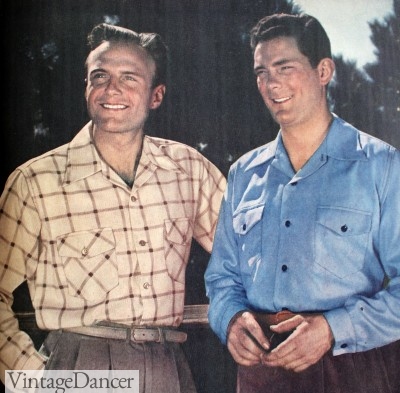
1943 Men’s Casual Shirts
The 1940s Hawaiian ‘Aloha’ shirt, featuring hand painted tropical scenes, birds, and flowers were introduced after the war. 1940s Hawaiian shirts were worn untucked and fit rather loose. They were imported from Hawaii, although most designers also made tropical themed sports shirt part of their mainland collection.
Learn more about 1940s men’s shirts. Shop 1940s inspired men’s shirts.
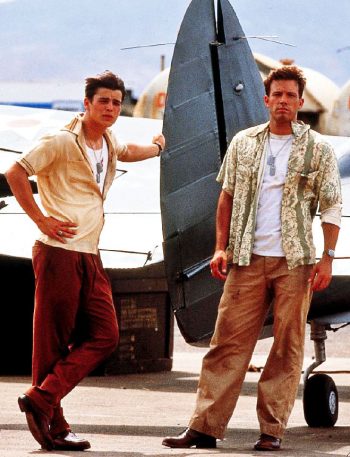
Pearl Harbor movie, (R) wearing an unbuttoned Hawaiian shirt
Hollywood’s wave of American Western movies spawned an interest in western style clothing for boys and men. Western shirts, hats, boots, and trousers were popular equally with city and country folk. You could say that the Urban cowboy fashion began in the 1940s.
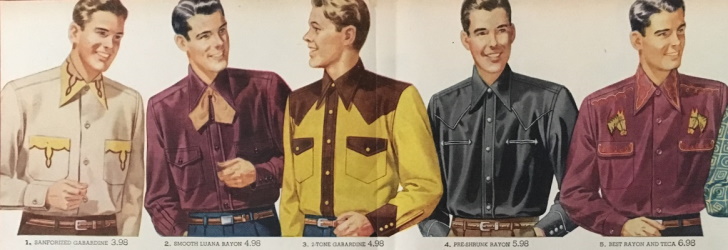
1948 Men’s Western Shirts
1940s Casual Trousers
Men’s 1940s trousers sold separately for casual day wear, sporting events and some work environments were a bit more colorful and comfortable than suit trousers.
Men’s 40s casual pants were made of lighter weight wool blends in the cooler months and even lighter cotton poplins, gabardine (rayon blend), or seersuckers for tropical climates. All season fabrics were wool flannel, cassimere, and sharkskin.
- 1940 men’s flat and pleat gabardine pants
- 1942 summer casual pants
Men’s 40s casual pants were sold in solid colors of green, blue and tan, while more unique patterns like plaid, pinstripes, diagonal stripes, pin check, and herringbone in medium blues, maroons, and browns were favored. Especially in the early years colors and patterns were brighter and bolder. Teal blue, baby yellow, and ocean green made for a colorful outfit.
Casual men’s 1940s trousers featured a narrowed high waist and full hips with straight wide legs. Flat fronts were preferred over a single pleat, although both were acceptable.
- 1943 dress pants with sport coats
- Casual pants and shirts
Men’s 1940s trouser waistbands had the dropped belt loops, which always had a thin leather belt worn with them. Shirts were worn tucked in, exposing the pants fully.
Men’s 40s casual shirts rarely matched the pants. Instead, tan pants were matching with maroon shirts, plaid with brown, pinstripes with blue, etc.
Men’s walking “shorts” were new in the late 1940s. Pleat leg knee length length shorts worn with T-shirts and polo shirts in summer. Shorter, thigh high shorts were for gym and sportswear only.
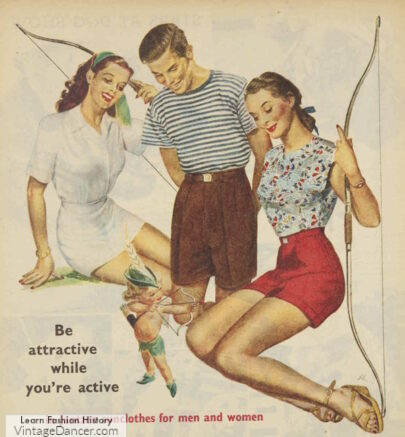
1948 men’s walking length shorts
1940s Men’s Sport Coats
1940s men’s sports coats, too, were a newer trend that gained popularity in the 1930s. They, too, came in a smattering of glenn plaids, herringbone, chevron checks, chalk stripes, and tweeds.
- 1944 sport coat outfits
- Sinatra wearing a brown plaid sport coat
40s sport coats were worn with solid color pants that were darker than the sport coat, with the exception of white pants, which were worn with a navy blue sport coat. A sweater vest in a bright color contrasted with the outfit. In the above outfit yellow, green and orange sweater vests were used. Not boring at all!
Men’s 1940s sport coats had wide rounded notch lapels, two very large square pockets, and 3 button closures. Pockets came in a variety of flap, slit, or patch styles.
Learn more about 1940s men’s casual clothing here: shirts, shorts, jeans, pants, sports coats etc
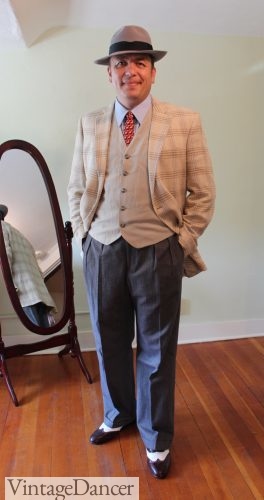
A 1940s sport coat ensemble
1940s Men’s Sweaters, Knitwear
Men’s 1940s sweaters or jumpers were generally wide or cable ribbed with a wide ribbed hem and cuffs that ended high on the waist. Men’s sweaters could be crewneck or a small V-neck.
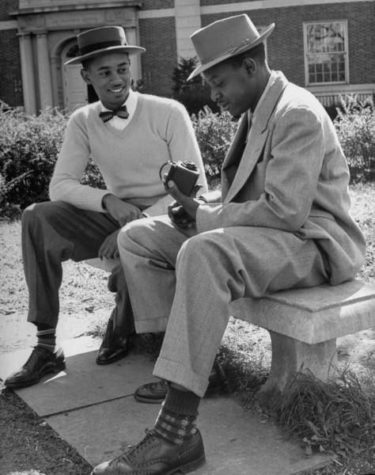
1946 Howard University students. man on the left wears a sweater over shirt and bow tie with pork pie hat.
- 1942-43 Men’s fall sweaters fashion
- 1948 men’s pattern cardigan and sweaters
Cardigan sweaters were a very popular look, with a V-neck and buttons down the front. Some men’s 1940s cardigans zipped up the front and featured a small, rounded stand-up collar.
Learn more about men’s sweaters and buy vintage style men’s sweaters.
As mentioned already, sweater vests were another popular layering piece, replacing suits vests. Plain or better yet, novelty, argyle, and two-tone patterns added in some fun and festive design to an otherwise dull wardrobe. The length was short to meet the top of men’s high waisted trousers. Learn about men’s 1940s sweaters vests.
- 1944 men novelty deer, argyle and plain V neck pullover sweaters
- 1944 men’s sweater vests
1940s Men’s Coats and Jackets
A wool overcoat was a winter staple for the ‘40s man. They were cut straight and very boxy, coming down to the knee at a very slight angle. The shoulders were rounded and sometimes came in Raglan cuts. They had very wide peak lapels and side-angled slit pockets. The buttons down the front were covered over with a long flap.
After the war, when wool restrictions were lifted, a double-breasted version became popular. It was worn with a wide belt at the waist. These overcoats were usually tan, plaid, tweed, or herringbone with plaid cotton flannel or rayon cotton blend linings.
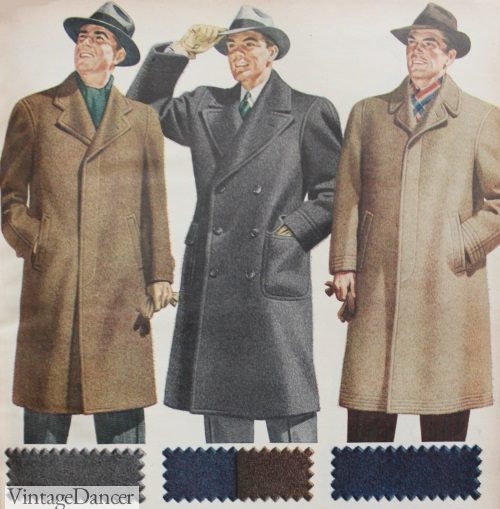
1943 Men’s Winter Coats
The trench coat was another classic ‘40s look, made especially popular by Humphrey Bogart in Casablanca (1942). It was the same shape as the overcoat – boxy and to the knee. It was worn without a belt and had side slit pockets and a very small pointed collar with virtually no lapels.
Later in the decade, a double-breasted version with a wide belt came into fashion (see a pattern here?). It had epaulets on the shoulders, wrist straps to keep the dampness out, and a D-ring belt loop that originally was used for carrying grenades. Trenches were cotton gabardine, almost always in tan (see image at top of article).
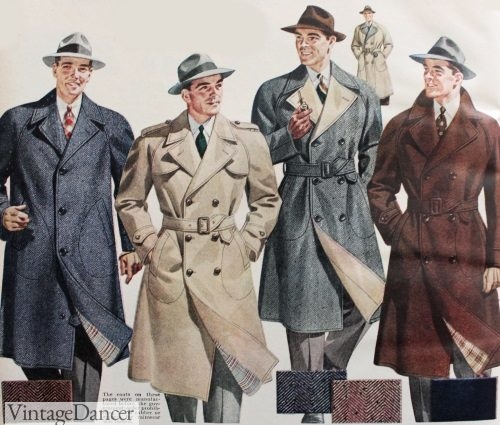
1943 Men’s Trench Coats
For spring and fall, a lighter jacket would do. Made from wool or cotton poplin, they had buttons down the front, pointed collars and small lapels. Patch pockets held the essentials.
Some 1940s men’s jackets were a pullover style without buttons at all, with cotton ribbed cuffs and hems instead. These had crew or V-necks.
Jacket colors were kept neutral – tan, brown or navy. For a spiffier look, navy or hunter green panels were inset into the fronts of tan jackets.
- 1944 leisure coat
- 1945 men’s plaid mackinaw jackets, bomber, and pea coat styles
One of the most iconic and collectible ’40s jackets today is often called the Gabardine jacket named after the material. It was made of a rayon and cotton twill blend that had a soft shine to it.
The smooth material made the design very plain with angled slit pockets on the sides, 5 buttons down the front (or a zipper in the later ’40s), and an optional chest pocket with a flap.
The jacket hung straight down to the waist and was fitted only with a half belt at the back and two adjustable side belts. The jacket collar was soft wide points worn loose and open for the most casual comfort.
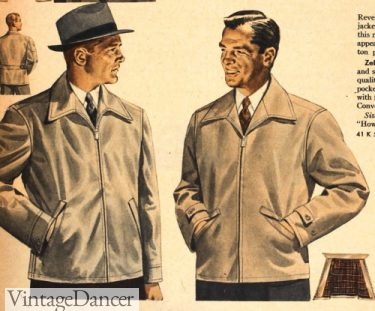
1944 gab jackets
Air force flight jackets were one of the most sought after military items for everyday wear. They were made from brown leather and sometimes had a cream fleece lining. One version came to the waist and had a pointed collar. Thick cotton ribbing at the cuffs and hem kept it snug.
Another flight jacket version was a little bit longer and belted at the waist with big front patch pockets.
De-regulated flight jackets were quickly snatched up by civilians in the post war years. Learn more about 1940s men’s coats and jackets.
Shop men’s vintage coats and jackets.
- Men wearing leather jackets
- 1944 brown leather jackets
1940s Men’s Fashion Hats
During the ‘40s, every man had a hat on his head! The fedora, also called a trilby, was by far the most widely worn style. It had a 2.5-3 inch brim and a tall pinched front crown with a center crease that was either flat-topped or angled to the back.
Men’s 1940s hats were made in wool felt and came in colors grey, black, dark brown, tan, or cream. The brim was usually bound in petersham ribbon that circled around the crown and ended with a flat bow on the side, sometimes with feathers.
- 1942 mens fedora hats
- 1943 mens pinch front fedora hats
The other popular felt hat of the 1940s was the homburg. It came only in grey or blue, with black slowly fading out of fashion by the mid forties. The crown was quite tall with a moderate center crease. The brim was curled all around, but especially on the sides, creating an oblong shaped fit.
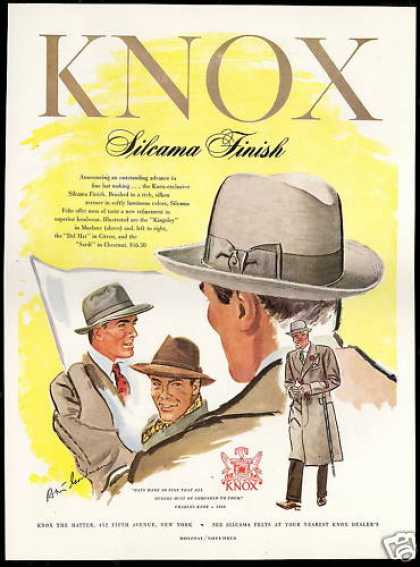
1948 Homburg hat by Knox
The curled edges were less tight than they were in the previous few decades, creating a wider, looser fitting hat. Black petersham ribbon bound the rim and hat band.
The trend was to wear the Homburg slightly pulled forward and down on the forehead. This was the last decade for the Homburg’s popularity other than a short surge of trendiness in the ’80s, when The Godfather movies were released.
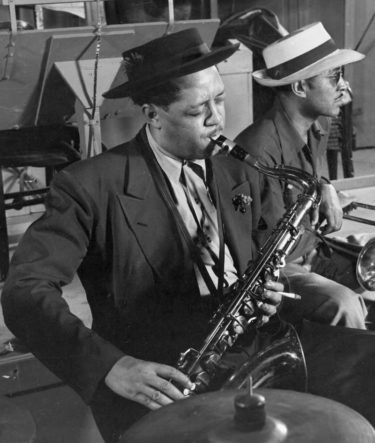
Lester Young wears a pork pie hat 1944
The most unique hat of the 1940s was the pork pie hat. Similar to a Victorian Gambler hat, it came in black or brown fur felt and featured a short oval flat top with deep crease around the oval. A wide curled brim all around with a matching petersham rim makes the pork pie stand apart from the gambler.
Wearing a pork pie hat at an angle with a thin leather hat band or wide petersham ribbon with flat bow in the same color as the hat kept it in style with the other felt hats of the 1940s.
- Late 40s men’s straw hats
- 1944 mens felt and straw hats
In tropical climates, wool hats were too hot. Instead, woven straw hats in the shapes of fedoras, pork pies, and boaters were worn as they had been for the prior two decades.
Read more about 1940s men’s hat history and buy new men’s 1940s style hats.
1940s Men’s Shoes
Shoes for men in the 1940s came in just a few styles. The most common everyday shoe was the lace up Oxford. Most Oxfords were a dark leather brown with a thick sole and sturdy heel. Details could include some brogue (small perforations) on the toe or in a fancy wingtip pattern.
Solid black was another option for formal suits and dark clothing, as was white for light summer suits.
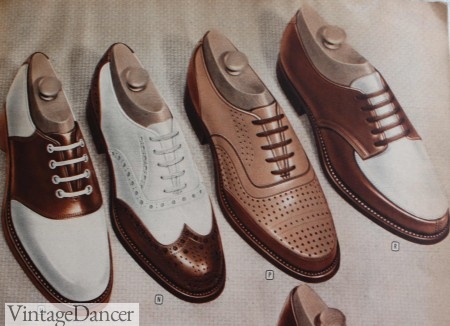
1940s mens two tone shoes
Most men chose to wear a more sporty Oxford– the two tone brown and white shoe. These were worn with business suits and casual clothing alike. The patterns of white and brown were diverse. They are THE iconic style of the 1940s.
Other casual options were moccasin style loafers, sandals for summer, winter boots and sneakers for sports. Tall or short lace-up sneakers looked like Converse shoes today but with a thicker sole. Learn more about 1940s men’s shoe styles and history.
Buy men’s 1940s style shoes here.
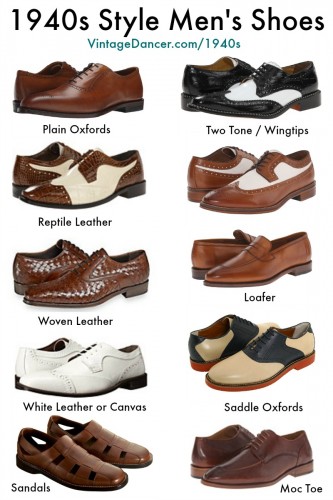
New 1940s style men’s shoes. Shop now.
Men’s 1940s socks were worn fairly tall, to about mid-calf. Work socks came in shorter, above the ankle, lengths. They were made of a ribbed wool or cotton or rayon blend with tighter ribbing at the top inch or two to hold them up. They were typically dark colors like brown, tan and blue, or light white and grey.
Just like ties, men’s 1940s socks also came in a wild range of colorful stripes, Art Deco patterns, and argyle designs.
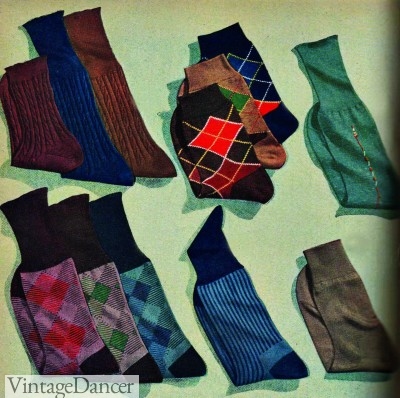
1940s Men’s Socks
Because elastic wasn’t used in socks yet, they tended to sag. Sock garters helped hold them up. They were an elastic or leather strap with two clips that grabbed the sock and another clip that wrapped around the calf tightly and held the socks in place.
Learn more about the history of men’s socks here.
More Men’s 1940s Fashion History
- 1940s Men’s Formalwear or wedding groom clothing
- 1940s Black Fashion, African American Clothing Photos | Gallery
- 1940s Men’s Swimsuits – Vintage swimwear through the decades
- Men’s Vintage Gym Clothes | Sweatshirts, Shorts, Tops, Shoes Styles
- 1940s Accessories – Watches, belt, suspenders, jewelry, scarf, etc
- Men’s Gloves History
- 1940s Men’s bags – Bookbags, briefcases, gym and travel bags
- 1940s Men’s Sunglasses and Eyeglasses
- 1940s Teenage Boys’ Fashion – Boys and young men’s styles
- 1940s Men’s Underwear – Boxers, briefs, long johns, socks, undershirts
- 1940s Men’s Pajamas, Robes, Slippers and smoking jackets
- 1940s Men’s Hairstyles and Facial Hair – Common styles, trends, grooming products
1940s Men’s Outfits
- 1940s Men’s Fashion and Costume Ideas – How to create classic 1940s looks for men, from business to casual styles.
- Casual Vintage Men’s Fashion – Ideas for casual menswear from the 1920s to 1960s.
- 1940s Men’s Outfit Inspiration- Photos of 1940s men’s outfits
- Building a Men’s Vintage Casual / Workwear Wardrobe
- Swing Dance Clothing for Men – A Guide to choosing 1940s swing dancing clothes that will keep you cool and comfortable.
- 1940s Men’s Costumes: WW2, Sailor, Zoot Suits, Gangsters, Detective
- Men’s Vintage Boating Outfits, Sailing Clothes
- Accurate 1940s and WWII Classic Car Show Outfits
- 1940s Zoot Suit History & Buy Modern Zoot Suits
- Film Noir Costume Ideas
- Men’s sewing patterns– vintage and repro men’s 1940s sewing patterns
- 1940s Men’s Reproduction Clothing Brands
Debbie Sessions has been teaching fashion history and helping people dress for vintage themed events since 2009. She has turned a hobby into VintageDancer.com with hundreds of well researched articles and hand picked links to vintage inspired clothing online. She aims to make dressing accurately (or not) an affordable option for all. Oh, and she dances too.
